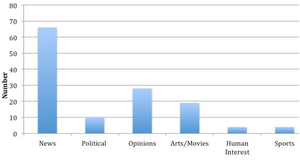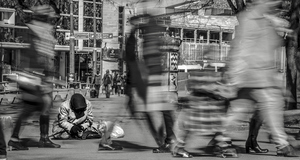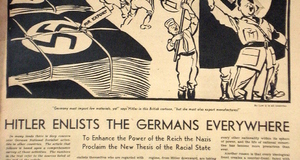Upon careful analysis of newspaper articles, broadcast, and magazine covers depicting both the Rodney King incident in 1991-1992 and the more recent Ferguson, Missouri, incident, notable differences between timeframes became apparent and several overlapping frames became noticeable.
First, almost all print articles contain wording that highlight the conflict and unrest in both situations. Words such as “outrage,” “skepticism,” and “controversy” inundate these articles. This is notable considering that articles for both stories were published soon after each incident. Considering the limited amount of time for public reaction between the time of the incident and time of publication, this raises the question, ‘Did these phrases describe the reality of the public’s initial reaction to each situation? Or did the media guide readers to believe this was the prescribed reaction to such events?’
This leads to the discussion of several overlapping frames discovered in many articles. Articles 1, 2, 3, 6, and 7 utilize a frame centered on black hardship. Article 1 and 5 utilize primary quotes from King, focusing on his side of the story and his own personal hardship. The fact that King was unemployed can be seen as a pathos appeal to persuade the reader to feel sympathy for the victim who might not have had the means to pay for his hospital stay. Mention of King’s previous second-degree robbery conviction also fits in with the black hardship frame.
In comparison, Articles 2, 6, and 8 read much more factually than Article 1. The lead paragraph of Article 2 includes the classic five W’s of journalism: who, what, when, where, and why. In contrast, the lead paragraph of Article 1 paints a picture of conflict and violence with broad statements, such as “alleged pattern of police brutality” and “official abuse of minorities.”
An overlapping, yet distinct, frame became apparent in Article 2. In the wake of several similar situations to the shooting of Michael Brown, the frame of black male youth misfortune has become salient in mass media. This frame can be seen as a more specific subset of the more general black misfortune frame analyzed in Articles 1 and 7. This frame is characterized by a focus on the innocence of the black male victim and the tragedy of the individual’s unfair and untimely death. The final quote from Brown’s mother in Article 2 illustrates this relevant frame: “Do you know how hard it was for me to get him to stay in school and graduate? You know how many black men graduate? Not many. Because you bring them down to this type of level, where they feel like they don’t got nothing to live for anyway.”
Lastly, the most overarching frame the researcher found was focused on the conflict between the Black community and authorities. Every media type analyzed for both stories emphasized the opposition between the Black public and the authorities. What’s different among media types and between two timeframes is the persuasion, or lack of persuasion, to choose one side of the conflict.
There is a clear difference in the framing of the two broadcast segments. ABC’s coverage of the Rodney King story in 1991 is factual in tone and presents the hard facts and footage of the incident. In contrast, ABC’s more recent coverage of the Ferguson, Missouri, story focuses on the riots and backlash from the incident with dramatic footage of police confronting protestors with tear gas. This focus on the conflict in Ferguson and the criticism of the police takes precedence over the facts of the story in the broadcast segment. There is an evident shift from the reporting style in 1991versus the framing and reporting of the Ferguson story.
Both Time magazine covers portrayed the events in similar ways. Both images depict bright, dramatic lights that indicate conflict and unrest. Cover 1 is more inflammatory with the statement “Can we all get along” compared to the more general caption, “The tragedy in Ferguson,” on Cover 2.
The differences in the print articles are significant in that coverage in Articles 1, 3, and 6 is focused on victim’s side of the story and the clearly defined wrongdoing by the authorities. Whereas the coverage in Articles 2, 5, 7, and 8 is more balanced with all facts from each incident and quotes from both witnesses and the police. Articles similar to Article 1 lead the reader to empathize with the victim and resent the authorities, whereas articles similar to Article 2 articulate both the police and the public’s perspective on the incident, but strongly persuade the reader to side with the public.
This analysis was limited to three types of mass media communication and 12 total items. While there are many more aspects to consider regarding this topic, time constraints restricted the researcher to the analysis of 12 sources in total.
News media serve as a powerful mode of communication and have incredible power in influencing public opinion on controversial topics. Agenda setting and framing are inherent to the process of communicating news to the public. These aspects of reporting are necessary to the news process and enable the public to make sense of seemingly unrelated events. For example, individual cases of suffering may be inserted into a larger story to illustrate the nature of the problem in human-interest terms.
This analysis demonstrates the changes and progression of the media’s framing of two similar stories that occurred in different contexts. All types of news media utilized an overarching frame focused on the conflict between the public and authority. The print articles and broadcast segments also utilized frames of black disadvantage and used the specific facts from each story to contribute to a larger theme.
These frames are all a part of a broader framing pattern by media. Each news organization and medium handles stories differently than others; however, media consolidation and commercialization impact the message the public receives. Consequentially this impacts the way the public reacts to controversial stories such as the unrest in Ferguson, Missouri.
The author would like to extend thanks to Dr. David Copeland, A.J. Fletcher Professor at Elon University, for his guidance, inspiration, and advice, all of which this article could not be published. The author also appreciates numerous reviewers who have helped revise this article.
- Baker, C.E. 2007 Media Concentration and Democracy: Why Ownership Matters. New York: Cambridge University Press.
- Barr, J. (1992, May 1). Time Magazine Cover.
- Biagi, S., & Foxworth, M. (1997). Facing difference: Race, gender, and mass media. Thousand Oaks, Calif.: Pine Forge Press.
- Bosman, J., Fitzsimmons, E. (2014, August 10). Grief and protests follow shooting of a teenager. The New York Times.
- Campbell, S., Chidester, P., Royer, J., & Bell, J. (2004). REMOTE CONTROL: HOW MASS MEDIA DELEGITIMIZE RIOTING AS SOCIAL PROTEST. Race, Gender & Class, 11(1), 158. Retrieved from https://ezproxy.elon.edu/login?url=http://search.proquest.com/docview/218834324?accountid=10730
- Dennis, E. (1997). The media in black and white. New Brunswick [N.J.: Transaction.
- Gamson, W. A., & Modigliani, A. (1987). The changing culture of affirmative action. In R. G. Braungart & M. M. Braungart (Eds.), Research in political sociology, 3, 137-177. Greenwich, CT: JAI Press.
- Haider-Markel, D., Delehanty, W., & Beverlin, M. (2007). Media framing and racial attitudes in the aftermath of katrina. Policy Studies Journal, 35(4), 587-605. Retrieved from https://ezproxy.elon.edu/login?url=http://search.proquest.com/docview/210550204?accountid=10730
- Iyengar, S., and Kinder, D. R. 1989 News that Matters: Television and American Opinion Chicago: University of Chicago Press.
- McCombs, M. E. 2004 Setting the Agenda: The Mass Media and Public Opinion. Cambridge Policy Press.
- McQuail, D. (1987). Mass communication theory: An Introduction (2nd ed.). Thousand Oaks, CA: Sage Publications.
- Mydans, S. (1991, March 7). Tape of beating by police revives charges of racism. The New York Times.
- Olson, S. (2014, September 1). Time Magazine Cover.
- Park, S., Holody, K. J., & Zhang, X. (2012). Race in media coverage of school shootings: A parallel application of framing theory and attribute agenda setting. Journalism and Mass Communication Quarterly, 89(3), 475-494. Retrieved from https://ezproxy.elon.edu/login?url=http://search.proquest.com/docview/1036601499?accountid=10730
- Reese, S. (2001). Framing public life perspectives on media and our understanding of the social world. Mahwah, N.J.: Lawrence Erlbaum Associates.
- Scafidi, F. G. (1991, Apr 04). The rodney king case through police eyes. The Washington Post (1974-Current File) Retrieved from https://ezproxy.elon.edu/login?url=http://search.proquest.com/docview/140551174?accountid=10730
- Scheufele, D. A. (1999). Framing as a theory of media effects. Journal of Communication, 49(1), 103-122. Retrieved from https://ezproxy.elon.edu/login?url=http://search.proquest.com/docview/233071672?accountid=10730
- Sexton, C. M. (2014). Zimmerman and martin as media’s ammunition: A social constructionist approach to race relations and gun violence. (Order No. 1556307, Southeastern Louisiana University). ProQuest Dissertations and Theses, , 81. Retrieved from https://ezproxy.elon.edu/login?url=http://search.proquest.com/docview/1540821177?accountid=10730. (1540821177).
- Shapiro, R. (2011). The Oxford handbook of American public opinion and the media. Oxford: Oxford University Press.
- Special to The New,York Times. (1992, May 02). Rodney king speaks out: ‘can we all get along?’. New York Times (1923-Current File) Retrieved from https://ezproxy.elon.edu/login?url=http://search.proquest.com/docview/108979158?accountid=10730
- Stevens, A., & Lubman, S. (1992, May 01). RODNEY KING VERDICT: THE AFTERMATH. Wall Street Journal (1923 - Current File)Retrieved from https://ezproxy.elon.edu/login?url=http://search.proquest.com/docview/135584992?accountid=10730
- Squires, C. R.(2014). Postracial Mystique: Media and Race in the 21st Century. New York: NYU Press. Retrieved October 29, 2014, from Project MUSE database.
Print Articles:
Article 1) New York Times, “Tape of Beating by Police Revives Charges of Racism,” (March 7, 1991)
Article 2) New York Times, “Grief and Protests Follow Shooting of a Teenager,” (August 11, 2014)
Article 3) Wall Street Journal, “RODNEY KING VERDICT: THE AFTERMATH: Deciding Moment of the Trial May Have Been Five Months Ago,” (May 1, 1992)
Article 4) Wall Street Journal, “Ferguson in Tweets: Violence Erupts Again in Missouri,” (August 16, 2014)
Article 5) New York Times, “Rodney King Speaks Out: ‘Can We All Get Along?’: A Plea for Calm,” (May 2, 1992)
Article 6) “New York Times Protests Flare After Ferguson Police Officer Is Not Indicted,” (November 24, 2014)
Article 7) The Washington Post, “The Rodney King Case Through Police Eyes,” (April 4, 1991)
Article 8) The Washington Post, “Prosecutor releases more Ferguson documents,” (December 13, 2014)
Broadcast Coverage:
Segment 1) ABC, Coverage of Rodney King story
Segment 2) ABC, Coverage of Michael Brown story
Magazine Covers:
Cover 1) Time Magazine, May 1992
Cover 2) Time Magazine, September 2014
Segment 1:
ABC Coverage of Rodney King story from https://www.youtube.com/watch?v=SW1ZDIXiuS4
Transcript
Anchor: “And now the story that might never have surfaced if someone hadn’t picked up his home video camera. We’ve all seen the video of Los Angeles Police Officers beating a man they had just pulled over. The city’s police chief said today he will support criminal charges against some of the men. Here’s ABC’s Gary Shepard.”
Cue amateur home video of incident
Reporter: “Stopped a 25 year old black man last night, then beat him, kicked him, and clubbed him, unaware than an amateur photographer was recording the incident. Gates believes ‘assault with a deadly weapon will be one of the charges’
Cue footage of Gates’ police statement of the facts.
Gates: “In our review we found that one of our officers struck him with batons between fifty-three and fifty-six times. One officer rendered six kicks and one officer one kick.”
Cue footage of LAPD, fire of riots, black police officer.
Reporter: “Civil rights organizations say the LAPD has a history of brutality and misconduct that goes back a quarter of a century including one incident that sparked the Watts riots. So far this year there have been over 125 complaints of police misconduct filed with watchdog organizations
Cue interview with Jose de Sosa, NAACP.
de Sosa: “We no longer want to have to wake up each morning not knowing what fear to expect next. Today we are not assured that the police are there to protect us.”
Cue reporter
Reporter: “But Chief Gates today called the LAPD a model department and said he has no plans to resign.”
Segment 2:
ABC Coverage of Ferguson story from https://www.youtube.com/watch?v=khQf4mCzFqU
Transcript
Anchor: “There’s violence in the streets of St. Louis and incredible pictures are coming in.
Cue video of tear gas and riots.
Anchor: “Police are in riot gear and firing tear gas to break up protesters angry over the shooting death of an unarmed teenager. The police chief is weighing in on whether or not to reveal the officer who shot him.”
Cue reporter.
Reporter: “There are many people here who believe the police could be using a much lighter hand; they arrested two reporters last night and an elected official because they didn’t move fast enough. A state senator said she had tear gas thrown at her and she approves the budget for state patrol. Even president Obama has been briefed on the developments here.”
Cue video of tear gas explosions.
Reporter: “Overnight protests turned violent again on the streets of Ferguson, Missouri. Police responded with tear gas and the crowd went running.”
Cue video of protesters marching.
Reporter: “As civil rights groups protest the police shooting that killed 18 year-old Michael Brown, and the lawsuits mount. [cue picture of brown, 1:05] The chief of police telling ABC his officer was hurt in the incident authorities say either Brown or his friend fought with the policeman before the shooting.”
Cue interview with police chief.
Police Chief: “His face was swollen so he’d obviously been hit or punched or something like that.”
Reporter: “He says he and his officers are getting death threats daily and says he won’t release the name of the officer involved in the shooting unless his officer is charged with a crime or a court makes him, and then he could always appeal. Prosecutors say it could take weeks before they decide if the shooting is a crime.”
Cue police department member giving public statement.
Police member: “We have difficulty reaching a lot of witnesses. We’re having trouble locating them.”
Cue video of community members interacting with police.
Reporter: “They are talking with Dorian Johnson who was walking with Brown when he says the officer tried to get them off the street.”
Johnson: “He tried to thrust his door open but we were so close to it that it ricocheted off us and it bounced back to him and I guess that got him a little upset.”
Cue exclusive video from the scene: covered body in middle of street.
Reporter: “Police say he started shooting from inside the vehicle. Listen as this neighbor describes what she saw. Subtitles: ‘the first shot he shot out of the car. The other shots he stood over him and pow pow pow pow pow.’ “
Cue video of tear gas.
Reporter: “For now the concern is that racial tensions here are about to explode.”
Cue video of reporter.
“There’s been a lot of talk that Michael brown had a record which his family feels is an offensive question, but this morning St. Louis County says no; no arrests, no convictions.”
Acknowledgments
The author would like to extend thanks to Dr. David Copeland, A.J. Fletcher Professor at Elon University, for his guidance, inspiration, and advice, all of which this article could not be published. The author also appreciates numerous reviewers who have helped revise this article.
Endnotes
- Baker, C.E. 2007 Media Concentration and Democracy: Why Ownership Matters. New York: Cambridge University Press.
- Barr, J. (1992, May 1). Time Magazine Cover.
- Biagi, S., & Foxworth, M. (1997). Facing difference: Race, gender, and mass media. Thousand Oaks, Calif.: Pine Forge Press.
- Bosman, J., Fitzsimmons, E. (2014, August 10). Grief and protests follow shooting of a teenager. The New York Times.
- Campbell, S., Chidester, P., Royer, J., & Bell, J. (2004). REMOTE CONTROL: HOW MASS MEDIA DELEGITIMIZE RIOTING AS SOCIAL PROTEST. Race, Gender & Class, 11(1), 158. Retrieved from https://ezproxy.elon.edu/login?url=http://search.proquest.com/docview/218834324?accountid=10730
- Dennis, E. (1997). The media in black and white. New Brunswick [N.J.: Transaction.
- Gamson, W. A., & Modigliani, A. (1987). The changing culture of affirmative action. In R. G. Braungart & M. M. Braungart (Eds.), Research in political sociology, 3, 137-177. Greenwich, CT: JAI Press.
- Haider-Markel, D., Delehanty, W., & Beverlin, M. (2007). Media framing and racial attitudes in the aftermath of katrina. Policy Studies Journal, 35(4), 587-605. Retrieved from https://ezproxy.elon.edu/login?url=http://search.proquest.com/docview/210550204?accountid=10730
- Iyengar, S., and Kinder, D. R. 1989 News that Matters: Television and American Opinion Chicago: University of Chicago Press.
- McCombs, M. E. 2004 Setting the Agenda: The Mass Media and Public Opinion. Cambridge Policy Press.
- McQuail, D. (1987). Mass communication theory: An Introduction (2nd ed.). Thousand Oaks, CA: Sage Publications.
- Mydans, S. (1991, March 7). Tape of beating by police revives charges of racism. The New York Times.
- Olson, S. (2014, September 1). Time Magazine Cover.
- Park, S., Holody, K. J., & Zhang, X. (2012). Race in media coverage of school shootings: A parallel application of framing theory and attribute agenda setting. Journalism and Mass Communication Quarterly, 89(3), 475-494. Retrieved from https://ezproxy.elon.edu/login?url=http://search.proquest.com/docview/1036601499?accountid=10730
- Reese, S. (2001). Framing public life perspectives on media and our understanding of the social world. Mahwah, N.J.: Lawrence Erlbaum Associates.
- Scafidi, F. G. (1991, Apr 04). The rodney king case through police eyes. The Washington Post (1974-Current File) Retrieved from https://ezproxy.elon.edu/login?url=http://search.proquest.com/docview/140551174?accountid=10730
- Scheufele, D. A. (1999). Framing as a theory of media effects. Journal of Communication, 49(1), 103-122. Retrieved from https://ezproxy.elon.edu/login?url=http://search.proquest.com/docview/233071672?accountid=10730
- Sexton, C. M. (2014). Zimmerman and martin as media’s ammunition: A social constructionist approach to race relations and gun violence. (Order No. 1556307, Southeastern Louisiana University). ProQuest Dissertations and Theses, , 81. Retrieved from https://ezproxy.elon.edu/login?url=http://search.proquest.com/docview/1540821177?accountid=10730. (1540821177).
- Shapiro, R. (2011). The Oxford handbook of American public opinion and the media. Oxford: Oxford University Press.
- Special to The New,York Times. (1992, May 02). Rodney king speaks out: ‘can we all get along?’. New York Times (1923-Current File) Retrieved from https://ezproxy.elon.edu/login?url=http://search.proquest.com/docview/108979158?accountid=10730
- Stevens, A., & Lubman, S. (1992, May 01). RODNEY KING VERDICT: THE AFTERMATH. Wall Street Journal (1923 - Current File)Retrieved from https://ezproxy.elon.edu/login?url=http://search.proquest.com/docview/135584992?accountid=10730
- Squires, C. R.(2014). Postracial Mystique: Media and Race in the 21st Century. New York: NYU Press. Retrieved October 29, 2014, from Project MUSE database.
Appendix 1: Sources of stories
Print Articles:
Article 1) New York Times, “Tape of Beating by Police Revives Charges of Racism,” (March 7, 1991)
Article 2) New York Times, “Grief and Protests Follow Shooting of a Teenager,” (August 11, 2014)
Article 3) Wall Street Journal, “RODNEY KING VERDICT: THE AFTERMATH: Deciding Moment of the Trial May Have Been Five Months Ago,” (May 1, 1992)
Article 4) Wall Street Journal, “Ferguson in Tweets: Violence Erupts Again in Missouri,” (August 16, 2014)
Article 5) New York Times, “Rodney King Speaks Out: ‘Can We All Get Along?’: A Plea for Calm,” (May 2, 1992)
Article 6) “New York Times Protests Flare After Ferguson Police Officer Is Not Indicted,” (November 24, 2014)
Article 7) The Washington Post, “The Rodney King Case Through Police Eyes,” (April 4, 1991)
Article 8) The Washington Post, “Prosecutor releases more Ferguson documents,” (December 13, 2014)
Broadcast Coverage:
Segment 1) ABC, Coverage of Rodney King story
Segment 2) ABC, Coverage of Michael Brown story
Magazine Covers:
Cover 1) Time Magazine, May 1992
Cover 2) Time Magazine, September 2014
Appendix II
Segment 1:
ABC Coverage of Rodney King story from https://www.youtube.com/watch?v=SW1ZDIXiuS4
Transcript
Anchor: “And now the story that might never have surfaced if someone hadn’t picked up his home video camera. We’ve all seen the video of Los Angeles Police Officers beating a man they had just pulled over. The city’s police chief said today he will support criminal charges against some of the men. Here’s ABC’s Gary Shepard.”
Cue amateur home video of incident
Reporter: “Stopped a 25 year old black man last night, then beat him, kicked him, and clubbed him, unaware than an amateur photographer was recording the incident. Gates believes ‘assault with a deadly weapon will be one of the charges’
Cue footage of Gates’ police statement of the facts.
Gates: “In our review we found that one of our officers struck him with batons between fifty-three and fifty-six times. One officer rendered six kicks and one officer one kick.”
Cue footage of LAPD, fire of riots, black police officer.
Reporter: “Civil rights organizations say the LAPD has a history of brutality and misconduct that goes back a quarter of a century including one incident that sparked the Watts riots. So far this year there have been over 125 complaints of police misconduct filed with watchdog organizations
Cue interview with Jose de Sosa, NAACP.
de Sosa: “We no longer want to have to wake up each morning not knowing what fear to expect next. Today we are not assured that the police are there to protect us.”
Cue reporter
Reporter: “But Chief Gates today called the LAPD a model department and said he has no plans to resign.”
Segment 2:
ABC Coverage of Ferguson story from https://www.youtube.com/watch?v=khQf4mCzFqU
Transcript
Anchor: “There’s violence in the streets of St. Louis and incredible pictures are coming in.
Cue video of tear gas and riots.
Anchor: “Police are in riot gear and firing tear gas to break up protesters angry over the shooting death of an unarmed teenager. The police chief is weighing in on whether or not to reveal the officer who shot him.”
Cue reporter.
Reporter: “There are many people here who believe the police could be using a much lighter hand; they arrested two reporters last night and an elected official because they didn’t move fast enough. A state senator said she had tear gas thrown at her and she approves the budget for state patrol. Even president Obama has been briefed on the developments here.”
Cue video of tear gas explosions.
Reporter: “Overnight protests turned violent again on the streets of Ferguson, Missouri. Police responded with tear gas and the crowd went running.”
Cue video of protesters marching.
Reporter: “As civil rights groups protest the police shooting that killed 18 year-old Michael Brown, and the lawsuits mount. [cue picture of brown, 1:05] The chief of police telling ABC his officer was hurt in the incident authorities say either Brown or his friend fought with the policeman before the shooting.”
Cue interview with police chief.
Police Chief: “His face was swollen so he’d obviously been hit or punched or something like that.”
Reporter: “He says he and his officers are getting death threats daily and says he won’t release the name of the officer involved in the shooting unless his officer is charged with a crime or a court makes him, and then he could always appeal. Prosecutors say it could take weeks before they decide if the shooting is a crime.”
Cue police department member giving public statement.
Police member: “We have difficulty reaching a lot of witnesses. We’re having trouble locating them.”
Cue video of community members interacting with police.
Reporter: “They are talking with Dorian Johnson who was walking with Brown when he says the officer tried to get them off the street.”
Johnson: “He tried to thrust his door open but we were so close to it that it ricocheted off us and it bounced back to him and I guess that got him a little upset.”
Cue exclusive video from the scene: covered body in middle of street.
Reporter: “Police say he started shooting from inside the vehicle. Listen as this neighbor describes what she saw. Subtitles: ‘the first shot he shot out of the car. The other shots he stood over him and pow pow pow pow pow.’ “
Cue video of tear gas.
Reporter: “For now the concern is that racial tensions here are about to explode.”
Cue video of reporter.
“There’s been a lot of talk that Michael brown had a record which his family feels is an offensive question, but this morning St. Louis County says no; no arrests, no convictions.”




















